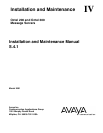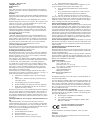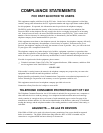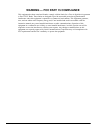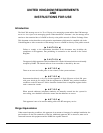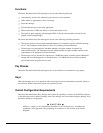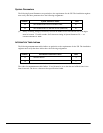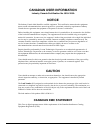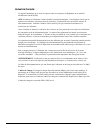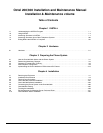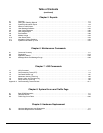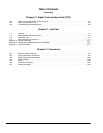
Copyright 2001, Avaya Inc.
All Rights Reserved
Printed in U.S.A.
Notice
Every effort was made to ensure that the information in this book was
complete and accurate at the time of printing. However , information is
subject to change.
Disclaimer
Intellectual property related to this product (including trademarks) and
registered to Lucent Technologies Inc. has been transferred or licensed
to Avaya Inc.
Any reference within the text to Lucent Technologies Inc. or Lucent
should be interpreted as references to Avaya Inc. The exception is cross
references to Avaya Inc. or to books published prior to April 1, 2001,
which may retain their original Lucent tittles.
Avaya Inc. formed as a result of Lucent’s planned restructuring, de-
signs, builds, and delivers voice, converged voice and data, customer
relationship management, messaging, multi−service networking and
structured cabling products and services. Avaya Labs is the research
and development arm for the company.
Preventing Toll Fraud
“Toll fraud” is the unauthorized use of your telecommunications sys-
tem by an unauthorized party (for example, a person who is not a cor-
porate employee, agent, subcontractor, or working on your company’s
behalf). Be aware that there may be a risk of toll fraud associated with
your system and that, if toll fraud occurs, it can result in substantial
additional charges for your telecommunications services.
Avaya Inc. Fraud Intervention:
If you suspect that you are being victimized by toll fraud and you need
technical assistance or support, call the Technical Service Center’s Toll
Fraud Intervention Hotline at 1−800−643−2353.
Providing Telecommunications Security
Telecommunications security (of voice, data, and/or video communica-
tions) is the prevention of any type of intrusion to (that is, either unau-
thorized or malicious access to or use of your company’s telecommu-
nications equipment) by some party.
Your company’s “telecommunications equipment” includes both this
Avaya product and any other voice/data/video equipment that could be
accessed via this Avaya product (that is, “networked equipment”).
An “outside party” is anyone who is not a corporate employee, agent,
subcontractor, or working on your company’s behalf. Whereas, a “ma-
licious party” is anyone (including someone who may be otherwise
authorized) who accesses your telecommunications equipment with
either malicious or mischievous intent.
Such intrusions may be either to/through synchronous (time−multi-
plexed and/or circuit−based) or asynchronous (character−, message−,or
packet−based) equipment or interfaces for reasons of:
S Utilization (of capabilities special to the accessed equip−
ment)
S Theft (such as, of intellectual property, financial assets, or
toll−facility access)
S Eavesdropping (privacy invasions to humans)
S Mischief (troubling, but apparently innocuous, tampering)
S Harm (such as harmful tampering, data loss or alteration,
regardless of motive or intent)
Be aware that there may be a risk of unauthorized intrusions associated
with your system and/or its networked equipment. Also realize that, if
such an intrusion should occur, it could result in a variety of losses to
your company (including but not limited to, human/data privacy, intel-
lectual property, material assets, financial resources, labor costs, and/or
legal costs).
Your Responsibility for Your Company’s Telecommunications Secu-
rity
The final responsibility for securing both this system and its net−
worked equipment rests with you − a Avaya customer’s system admin-
istrator, your telecommunications peers, and your managers. Base the
fulfillment of your responsibility on acquired knowledge and resources
from a variety of sources including but not limited to:
S Installation documents
S System administration documents
S Security documents
S Hardware−/software−based security tools
S Shared information between you and your peers
S Telecommunications security experts
To prevent intrusions to your telecommunications equipment, you and
your peers should carefully program and configure your:
S Avaya−provided telecommunications systems and their
interfaces
S Avaya−provided software applications, as well as their un-
derlying hardware/software platforms and interfaces
S Any other equipment networked to your Avaya products.
Avaya Inc. does not warrant that this product or any of its networked
equipment is either immune from or will prevent either unauthorized or
malicious intrusions. Avaya Inc. will not be responsible for any charges,
losses, or damages that result from such intrusions.
Federal Communications Commission Statement
Part 15: Class A Statement. This equipment has been tested and found
to comply with the limits for a Class A digital device, pursuant to Part 15
of the FCC Rules. These limits are designed to provide reasonable protec-
tion against harmful interference when the equipment is operated in a
commercial environment. This equipment generates, uses, and canradiate
radio−frequency energy and, if not installed and used in accordance with
the instruction manual, may cause harmful interference to radio commu-
nications. Operation of this equipment in a residential area is likely to
cause harmful interference, in which case the user will be required to cor-
rect the interference at his/her own expense.
Part 68: Network Registration Number. This equipment is registered
with the FCC in accordance with Part 68 of the FCC Rules. Refer to the
FCC Part 68 Notice to Users Compliance Statements in the Product De-
scription Volume.
Canadian Department of Communications (DOC)
Interference Information
This digital apparatus does not exceed the Class A limits for radio noise
emissions set out in the radio interference regulations of the Canadian De-
partment of Communications.
Le PrésentAppareil Nomérique n’émet pas debruits radioélec−triques dé-
passant les limites applicables aux appareils numériques de la class A
préscrites dans le reglement sur le brouillage radioélectrique édicté par le
ministére des Communications du Canada.
Ordering Information
Call: Avaya Publications Center
Voice 1−800−457−1235
International Voice 317−361−5353
Fax 1−800−457−1764 International Fax 317−361−5355
Write: Avaya Publications Center
2855 North Franklin Road
Indianapolis, IN 46219
Order: Document No. PB60019-01
March 2001
For additional documents, refer to the section in “About This Book” en-
titled “Related Documents.”
You can beplaced on astanding order listfor thisand other documents you
may need. Standing order will enable you to automatically receive up-
dated versions of individual documents or document sets, billed to ac-
count information that you provide. For more information on standing or-
ders, or to be put on a list toreceive future issues of this document, contact
the Avaya Publications Center.
European Union Declaration of Conformity
The “CE” mark affixed to the DEFINITY ONE equipment described in
this book indicates that the equipment conforms to the following Euro-
pean Union (EU) Directives:
S Electromagnetic Compatibility (89/336/EEC)
S Low Voltage (73/23/EEC)
S Telecommunications Terminal Equipment (TTE) i−CTR3
BRI and i−CTR4 PRI
The “CE” mark affixed to the equipment
means that it conforms to the above
directives.
For more information on standards compliance, contact your local
distributor.
Comments
Please send an email message to infodev@avaya.com with your com-
ments about this document.



